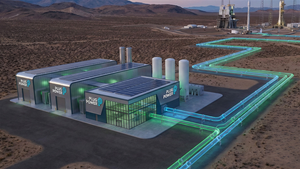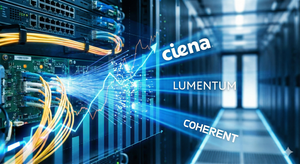
China has officially debuted the CHIEF1300, a groundbreaking centrifuge hailed as the "world’s mightiest," capable of generating an astonishing 300 times Earth’s gravity. This colossal machine, a cornerstone of the Centrifugal Hypergravity and Interdisciplinary Experiment Facility (CHIEF) under construction in Hangzhou, marks a significant leap in hypergravity research capabilities. Its immediate implications are profound, promising to revolutionize studies in deep-earth resources, disaster mitigation, and advanced materials synthesis, while firmly positioning China at the forefront of global scientific innovation.
The CHIEF1300 is not merely a scientific instrument; it's a "space-time compressor," allowing researchers to simulate large-scale, long-duration natural phenomena in condensed laboratory settings. With the ability to handle payloads up to 20 tonnes under extreme gravitational forces, this facility is set to unlock new frontiers in understanding complex physical processes, from simulating powerful earthquakes to modeling the long-term effects of tsunamis on seabeds. This strategic investment underscores China's ambition to lead in critical scientific disciplines and foster international collaboration in a new era of experimental physics.
Unprecedented Power: The CHIEF1300's Technical Prowess and Early Triumphs
The CHIEF1300 centrifuge, a marvel of engineering, began its operations on September 29, 2025, as a pivotal component of the Centrifugal Hypergravity and Interdisciplinary Experiment Facility (CHIEF) in Hangzhou, spearheaded by Zhejiang University. This facility is designed to be the largest of its kind globally, boasting the capacity to generate forces up to 300 times Earth's gravity (300G) for payloads weighing an impressive 20 to 22 tonnes. The larger CHIEF complex, which includes two additional centrifuges currently under construction, is expected to be fully operational by the end of 2026 and is engineered to eventually sustain accelerations of up to 1,500G. The centrifuge features a massive arm with a 6.4-meter radius, operating within a 230-square-meter circular basement, equipped with advanced vacuum and wall-cooling systems to minimize air resistance and heating under extreme conditions.
This "space-time compressor" functionality has already demonstrated remarkable potential in pilot tests. Researchers have successfully simulated intense earthquakes to validate the seismic performance of hydropower dam foundations, providing invaluable data for critical infrastructure safety. Furthermore, the facility has quantified the effects of significant waves and tsunamis on seabeds, crucial information for the optimal site selection of offshore wind farms. Deep-sea pressures relevant to methane hydrate extraction have also been simulated, offering insights into unlocking new energy resources. The CHIEF1300 has also played a role in the synthesis of advanced metal alloys exhibiting superior strength and ductility, paving the way for next-generation materials. Chen Yunmin, chief scientist of the CHIEF facility, has emphasized its role as an international research platform, inviting global collaboration to accelerate discovery and innovation.
Market Shifts: Winners and Losers in the Wake of Hypergravity Innovation
The debut of the CHIEF1300 is poised to create significant ripples across various industries, particularly in engineering, materials science, aerospace, and environmental solutions. Companies that strategically engage with or leverage the research outputs from this cutting-edge facility are likely to emerge as leaders, while those reliant on slower, less rigorous traditional methods may face increasing competitive pressure.
In the engineering sector, global civil and geotechnical engineering firms such as Arup, AECOM (NYSE: ACM), and Jacobs Engineering Group (NYSE: J) stand to win. Their ability to integrate advanced simulation capabilities for seismic validation of infrastructure or tsunami impact modeling for offshore projects could give them a significant competitive edge, leading to more robust and safer designs. Similarly, deep-sea engineering and resource extraction companies like TechnipFMC (NYSE: FTI) and Subsea 7 could accelerate the development of specialized equipment for challenging environments like methane hydrate extraction. Conversely, engineering firms that fail to adapt to these advanced simulation and testing capabilities may find their design processes becoming less competitive.
The materials science sector is also set for a transformation. Advanced materials manufacturers such as Alcoa Corporation (NYSE: AA), Arconic Corporation (NYSE: ARNC), Hexcel Corporation (NYSE: HXL), and Toray Industries (TYO: 3402) could see rapid advancements in developing next-generation metals, ceramics, and composites. The CHIEF1300's ability to synthesize advanced metal alloys with high strength and ductility under extreme conditions will significantly shorten R&D cycles. Specialty chemicals and additive manufacturing companies like DuPont (NYSE: DD), BASF (ETR: BAS), 3D Systems (NYSE: DDD), and Stratasys (NASDAQ: SSYS) may also find new applications and demands for their products. Traditional materials producers without a strong R&D focus, however, might struggle to compete with superior materials developed through hypergravity research.
For the aerospace sector, the implications are substantial. Major aerospace manufacturers like Boeing (NYSE: BA), Airbus (EPA: AIR), Lockheed Martin (NYSE: LMT), and Northrop Grumman (NYSE: NOC) could accelerate the development of lighter, stronger, and more heat-resistant materials crucial for next-generation aircraft and spacecraft, including those for hypersonic travel and space exploration. Companies like SpaceX, Rocket Lab (NASDAQ: RKLB), and Maxar Technologies (NYSE: MAXR) could leverage data from CHIEF1300 to develop more resilient and efficient spacecraft components. Suppliers of less robust or obsolete aerospace materials, however, might see reduced demand as new, high-performance alternatives emerge.
Finally, in the environmental solutions sector, firms like Tetra Tech (NASDAQ: TTEK), GHD, and Arcadis (AMS: ARCAD) could benefit immensely from the CHIEF1300's "space-time compressor" function. Its capability to simulate century-long contamination processes or geological evolution in days allows for faster and more accurate predictive modeling for environmental risk assessment, remediation, and complex underground waste disposal. This could lead to more effective and potentially patented solutions. Companies relying on outdated or less precise environmental models may find their offerings less credible.
Global Implications: Reshaping Scientific Leadership and International Collaboration
The CHIEF1300 centrifuge, launched in late September 2025, extends beyond a mere technological achievement; it represents a strategic move by China to reshape global scientific leadership and foster new paradigms of international collaboration. This facility, a hypergravity and interdisciplinary experiment hub, aligns with a broader global trend of nations investing heavily in mega-science infrastructure to push the frontiers of fundamental and applied research. Its "space-time compressor" capability, allowing simulations of century-long processes in days, is a game-changer for fields ranging from deep-earth resource extraction and disaster mitigation to materials science and environmental engineering.
The ripple effects of CHIEF1300 are manifold. On the competitive front, it sets a new global benchmark for hypergravity research. Other nations and research institutions will undoubtedly assess their own strategic investments in light of China's enhanced capabilities, potentially spurring a new wave of infrastructure development to maintain scientific competitiveness. However, the CHIEF project's chief scientist, Chen Yunmin, has openly invited international collaboration, positioning the facility as a global research platform. This overture could lead to significant partnerships, fostering breakthroughs too complex for any single entity, while simultaneously enhancing China's scientific diplomacy and integration into global research networks.
From a regulatory and policy perspective, the CHIEF1300's advanced capabilities, particularly in materials science and aerospace simulations, could have dual-use implications. While distinctly separate from nuclear enrichment centrifuges, the advanced materials and engineering techniques developed under extreme gravitational forces could benefit both civilian and military applications. This raises considerations for intellectual property, technology transfer, and collaboration agreements, especially with international partners, to ensure compliance with China's evolving export control regulations (updated in December 2024 for dual-use items) and international non-proliferation norms.
Historically, the development of such monumental research facilities mirrors the impact of particle accelerators like the Large Hadron Collider or space telescopes like the James Webb. These projects define generations of scientific inquiry and signify a nation's commitment to advancing science and engineering on a grand scale. While distinct from the historical proliferation concerns associated with nuclear enrichment centrifuges, the CHIEF1300's significance lies in its potential to revolutionize hypergravity-related research, much as other mega-science projects have done in their respective domains, demonstrating China's growing capacity for independent innovation and leadership in cutting-edge scientific infrastructure.
The Road Ahead: Pioneering Discoveries and Evolving Strategic Landscapes
As the CHIEF complex moves towards full operational status by the end of 2026, with the CHIEF1300 already online since September 29, 2025, the short-term focus will be on expanding research and validating the capabilities of its two additional centrifuges and 18 in-flight devices. This period will be crucial for fine-tuning the advanced systems, including vacuum and wall-cooling setups, and establishing initial international partnerships to define collaborative projects. The early success in simulating a 7.5-magnitude earthquake, a 65-foot tsunami, and deep-sea pressures, alongside testing aerospace alloys and compressing pollutant migration, sets a high bar for future achievements.
Long-term, beyond 2026, the fully operational CHIEF complex is poised to drive significant advancements across multiple scientific domains. It promises breakthroughs in Earth sciences through accelerated simulations of geological evolution and hydrogeological catastrophes, leading to improved disaster prediction and mitigation strategies. In materials science, the hypergravity environment is ideal for synthesizing new materials and testing aerospace alloys under extreme conditions, with applications spanning aerospace, construction, and other high-tech industries. The facility will also enhance research into deep-ocean and deep-earth resource extraction, potentially unlocking new, more efficient, and safer methods for accessing critical resources, and aid in optimizing underground waste disposal. Ultimately, by attracting leading scientists and facilitating groundbreaking research, China aims to solidify its position as a global leader in hypergravity and interdisciplinary science.
Strategic pivots and adaptations will be crucial for the CHIEF complex's sustained success. It must maintain a responsive research agenda, adapting to emerging global scientific priorities. Sustaining and expanding international engagement will require continuous efforts in fostering open scientific exchange, establishing clear data sharing protocols, and carefully navigating intellectual property concerns to attract and retain global research talent. Regular technological upgrades will also be essential to keep the CHIEF complex at the forefront of hypergravity research.
Market opportunities arising from the CHIEF complex are significant, including the potential commercialization of research findings in new materials, resource extraction techniques, and disaster mitigation technologies, leading to licensing agreements and spin-off companies. The facility's unique capabilities will also attract top-tier scientific and engineering talent, fostering innovation and economic growth in related sectors, and it could offer specialized testing and simulation services to industries requiring hypergravity environments. However, challenges such as high operational costs, intense global competition from other advanced scientific facilities, and the complex management of data security and intellectual property rights in international collaborations will need careful navigation.
Potential scenarios range from the CHIEF complex becoming a global research powerhouse, making significant breakthroughs that enhance China's scientific prestige and attract international investment, to a more domestically focused strategic asset supporting national goals. A less favorable scenario could see the facility encountering technical or financial hurdles, slowing down research output and diminishing its competitive edge. The facility's ultimate success will hinge on its ability to maintain technological leadership, attract global talent, and adapt to evolving scientific and geopolitical landscapes.
Final Spin: A New Gravity in Scientific Endeavor
The debut of China's CHIEF1300 centrifuge marks a pivotal moment in scientific research, establishing an unprecedented capability for hypergravity experimentation. This facility is not merely a testament to engineering prowess but a strategic investment in accelerating fundamental and applied sciences across a spectrum of critical fields. Its "space-time compressor" function promises to revolutionize how we study long-duration, large-scale phenomena, offering insights that were previously unattainable or prohibitively time-consuming.
Moving forward, the market will not see a direct commercial impact from the CHIEF1300 itself, but rather significant indirect effects through accelerated R&D and the subsequent development of new technologies and materials. China's move positions it as a global leader in hypergravity research, potentially shifting the epicenter for certain advanced experimental sciences and fostering a new era of international scientific collaboration. The lasting impact will be felt across scientific disciplines, fostering innovations in disaster mitigation, resource extraction, and advanced materials, thereby cementing China's role as a major contributor to global scientific advancement.
Investors, as of October 6, 2025, should keenly watch for several indicators in the coming months. Official announcements of research breakthroughs from the CHIEF facility, particularly in areas like advanced metal alloys or novel deep-sea technologies, could signal emerging opportunities in related industries. Pay close attention to any international partnerships or funding announcements involving Zhejiang University or the CHIEF complex, as these will highlight areas of high potential and collaborative interest. Furthermore, observe developments in sectors poised to benefit, such as specialized civil engineering firms, advanced materials manufacturers, and deep-sea exploration companies. Finally, keep an eye on how China's future government policies, especially the upcoming 15th Five-Year Plan (starting 2026), prioritize and fund research stemming from this facility, as this will underscore its long-term strategic importance.
This content is intended for informational purposes only and is not financial advice





